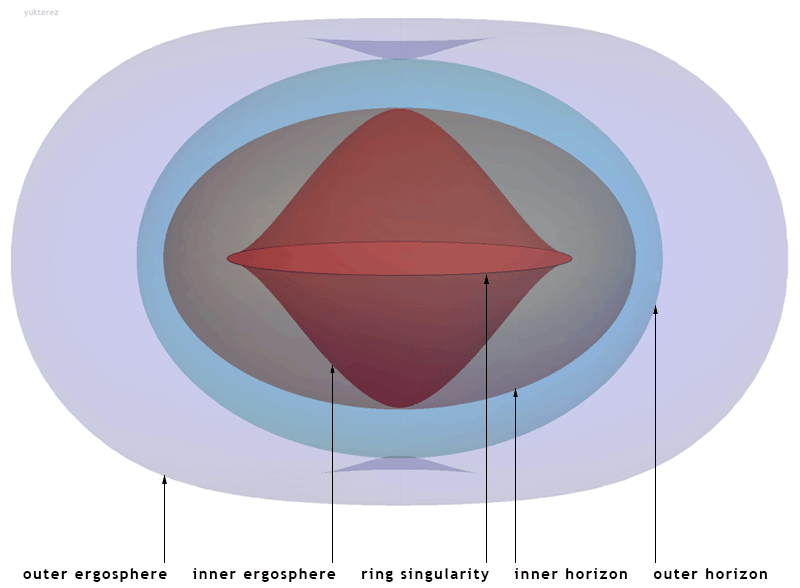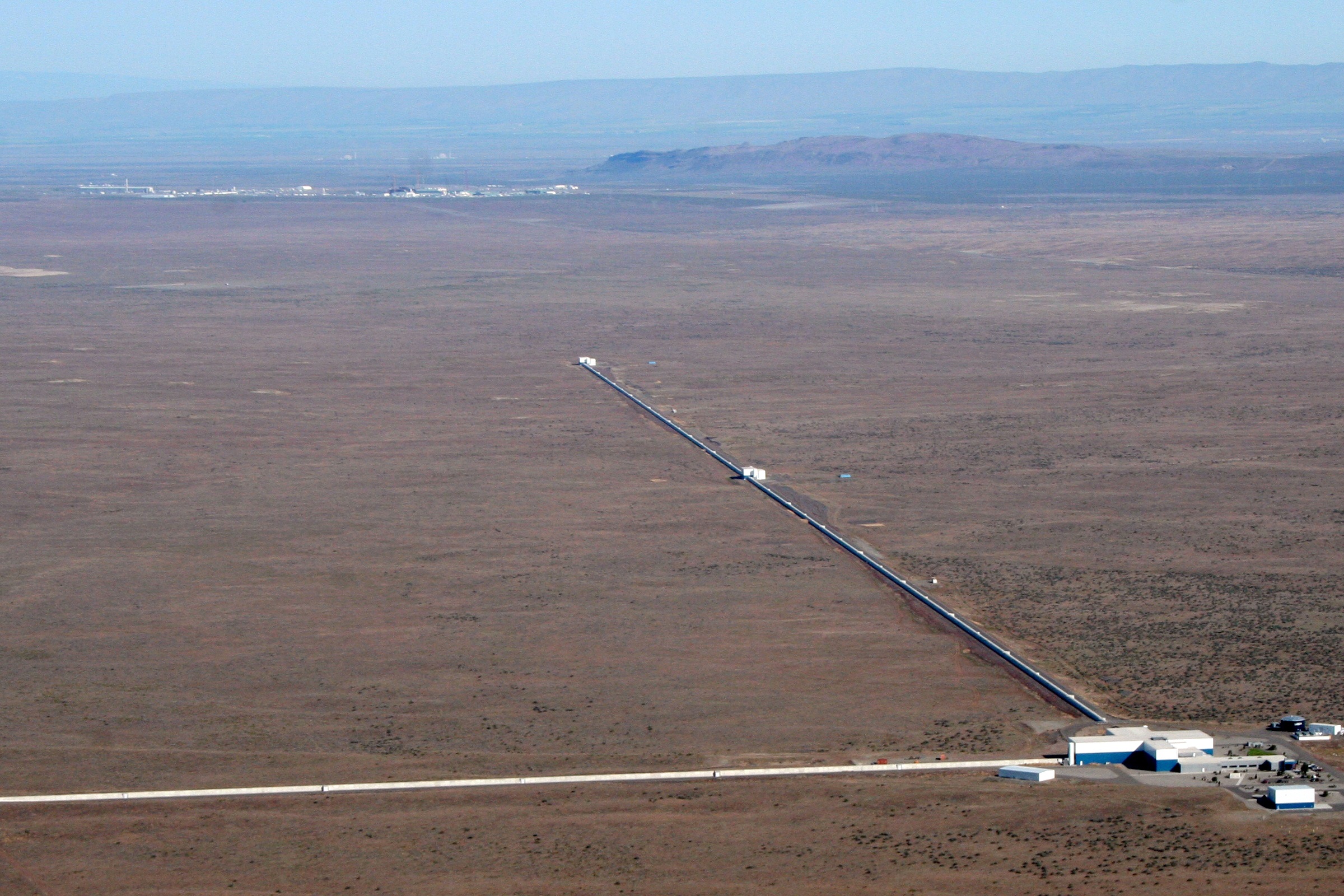|
Naked Singularity
In general relativity, a naked singularity is a hypothetical gravitational singularity without an event horizon. In a black hole, the singularity is completely enclosed by a boundary known as the event horizon, inside which the curvature of spacetime caused by the singularity is so strong that light cannot escape. Hence, objects inside the event horizon—including the singularity itself—cannot be directly observed. A naked singularity, by contrast, would be observable from the outside. The theoretical existence of naked singularities is important because their existence would mean that it would be possible to observe the collapse of an object to ''infinite density''. It would also cause foundational problems for general relativity, because general relativity cannot make predictions about the evolution of space-time near a singularity. In generic black holes, this is not a problem, as an outside viewer cannot observe the space-time within the event horizon. Naked singularities h ... [...More Info...] [...Related Items...] OR: [Wikipedia] [Google] [Baidu] |
General Relativity
General relativity, also known as the general theory of relativity and Einstein's theory of gravity, is the geometric theory of gravitation published by Albert Einstein in 1915 and is the current description of gravitation in modern physics. General relativity generalizes special relativity and refines Newton's law of universal gravitation, providing a unified description of gravity as a geometric property of space and time or four-dimensional spacetime. In particular, the ' is directly related to the energy and momentum of whatever matter and radiation are present. The relation is specified by the Einstein field equations, a system of second order partial differential equations. Newton's law of universal gravitation, which describes classical gravity, can be seen as a prediction of general relativity for the almost flat spacetime geometry around stationary mass distributions. Some predictions of general relativity, however, are beyond Newton's law of universal gravitat ... [...More Info...] [...Related Items...] OR: [Wikipedia] [Google] [Baidu] |
Kerr Metric
The Kerr metric or Kerr geometry describes the geometry of empty spacetime around a rotating uncharged axially symmetric black hole with a quasispherical event horizon. The Kerr metric is an exact solution of the Einstein field equations of general relativity; these equations are highly non-linear, which makes exact solutions very difficult to find. Overview The Kerr metric is a generalization to a rotating body of the Schwarzschild metric, discovered by Karl Schwarzschild in 1915, which described the geometry of spacetime around an uncharged, spherically symmetric, and non-rotating body. The corresponding solution for a ''charged'', spherical, non-rotating body, the Reissner–Nordström metric, was discovered soon afterwards (1916–1918). However, the exact solution for an uncharged, ''rotating'' black hole, the Kerr metric, remained unsolved until 1963, when it was discovered by Roy Kerr.Melia, Fulvio (2009). "Cracking the Einstein code: relativity and the birth of black ... [...More Info...] [...Related Items...] OR: [Wikipedia] [Google] [Baidu] |
Empty Space (novel)
Empty space may refer to: Physics * Outer space, especially the relatively empty regions of the universe outside the atmospheres of celestial bodies * Vacuum, a volume of space that is essentially empty of matter, such that its gaseous pressure is much less than atmospheric pressure * Free space, a perfect vacuum as expressed in the classical physics model * Vacuum state, a perfect vacuum based on the quantum mechanical model * In mathematical physics, the homogeneous equation may correspond to a physical theory formulated in empty space *Void, empty space. Arts and literature * '' Empty Space'', a novel by M. John Harrison *''The Empty Space'', a 1968 book by the British director Peter Brook * Empty Space Peter Brook Award, an annual prize awarded to a British theatre Music Albums * ''Empty Space'', a 2003 album by Lycia *''Empty Space'', a 2011 album by Buckethead Songs * "Empty Space" (song), a 2018 song by James Arthur *"Empty Space", a 2002 song by Lifehouse from ''Stanley ... [...More Info...] [...Related Items...] OR: [Wikipedia] [Google] [Baidu] |
Nova Swing
''Nova Swing'' is a science fiction novel by M. John Harrison published in 2006. It takes place in the same universe as ''Light''. The novel won the Arthur C. Clarke and Philip K. Dick Awards in 2007. Overview ''Nova Swing'' takes place long after the events of ''Light'', which focussed on a disturbance in the space-time continuum known as the Kefahuchi Tract. The novel's thematic focus is the 'event zone' at the centre of the city Saudade, a space-time membrane created when a piece of the Tract fell to the ground, transforming the appearance and even physics of the event site. The zone draws tourists from Saudade, led by hardened guide Vic Serotonin, who specializes in dangerous "tours" of this chaotic zone. Many of the narrative's threads play out as a consequence of 'artefacts' being brought out of the event zone by tourists. The motif of the event zone recalls the Zone in ''Roadside Picnic'' by Boris and Arkady Strugatsky. The novel incorporates some aspects of noir fic ... [...More Info...] [...Related Items...] OR: [Wikipedia] [Google] [Baidu] |
Light (novel)
''Light'' is a science fiction novel by M. John Harrison published in 2002. It received the James Tiptree, Jr. Award and a BSFA nomination in 2002, and was shortlisted for the Arthur C. Clarke Award in 2003. The Guardian ranked ''Light'' #91 in its list of 100 Best Books of the 21st Century. Overview The book centres on the lives of three individuals — the physicist (and serial killer) Michael Kearney, on the verge of a breakthrough in theoretical physics sometime in 1999; Seria Mau Genlicher, the cybernetically-altered female pilot of a "K-ship", and the ex-space pilot and adventurer Ed Chianese. Seria Mau and Ed's stories take place in the year 2400 AD. The lives of these three individuals are linked in many ways, though most tangibly by the presence of a mysterious creature called The Shrander, who appears in many guises to all three characters throughout the novel (with anagrammatic names of Sandra Shen and Dr. Haends). They are also linked by the Kefahuchi Tract, ... [...More Info...] [...Related Items...] OR: [Wikipedia] [Google] [Baidu] |
Science Fiction
Science fiction (sometimes shortened to Sci-Fi or SF) is a genre of speculative fiction which typically deals with imaginative and futuristic concepts such as advanced science and technology, space exploration, time travel, parallel universes, extraterrestrial life, sentient artificial intelligence, cybernetics, certain forms of immortality (like mind uploading), and the singularity. Science fiction predicted several existing inventions, such as the atomic bomb, robots, and borazon, whose names entirely match their fictional predecessors. In addition, science fiction might serve as an outlet to facilitate future scientific and technological innovations. Science fiction can trace its roots to ancient mythology. It is also related to fantasy, horror, and superhero fiction and contains many subgenres. Its exact definition has long been disputed among authors, critics, scholars, and readers. Science fiction, in literature, film, television, and other media, has beco ... [...More Info...] [...Related Items...] OR: [Wikipedia] [Google] [Baidu] |
GW150914
The first direct observation of gravitational waves was made on 14 September 2015 and was announced by the LIGO and Virgo collaborations on 11 February 2016. Previously, gravitational waves had been inferred only indirectly, via their effect on the timing of pulsars in binary star systems. The waveform, detected by both LIGO observatories, matched the predictions of general relativity for a gravitational wave emanating from the inward spiral and merger of a pair of black holes of around 36 and 29 solar masses and the subsequent "ringdown" of the single resulting black hole. The signal was named GW150914 (from ''gravitational wave'' and the date of observation 2015-09-14). It was also the first observation of a binary black hole merger, demonstrating both the existence of binary stellar-mass black hole systems and the fact that such mergers could occur within the current age of the universe. This first direct observation was reported around the world as a remarkable accomplishme ... [...More Info...] [...Related Items...] OR: [Wikipedia] [Google] [Baidu] |
LIGO
The Laser Interferometer Gravitational-Wave Observatory (LIGO) is a large-scale physics experiment and observatory designed to detect cosmic gravitational waves and to develop gravitational-wave observations as an astronomical tool. Two large observatories were built in the United States with the aim of detecting gravitational waves by laser interferometry. These observatories use mirrors spaced four kilometers apart which are capable of detecting a change of less than one ten-thousandth the charge diameter of a proton. (that is, to Proxima Centauri at ). The initial LIGO observatories were funded by the United States National Science Foundation (NSF) and were conceived, built and are operated by Caltech and MIT. They collected data from 2002 to 2010 but no gravitational waves were detected. The Advanced LIGO Project to enhance the original LIGO detectors began in 2008 and continues to be supported by the NSF, with important contributions from the United Kingdom's Science ... [...More Info...] [...Related Items...] OR: [Wikipedia] [Google] [Baidu] |
New Scientist
''New Scientist'' is a magazine covering all aspects of science and technology. Based in London, it publishes weekly English-language editions in the United Kingdom, the United States and Australia. An editorially separate organisation publishes a monthly Dutch-language edition. First published on 22 November 1956, ''New Scientist'' has been available in online form since 1996. Sold in retail outlets (paper edition) and on subscription (paper and/or online), the magazine covers news, features, reviews and commentary on science, technology and their implications. ''New Scientist'' also publishes speculative articles, ranging from the technical to the philosophical. ''New Scientist'' was acquired by Daily Mail and General Trust (DMGT) in March 2021. History Ownership The magazine was founded in 1956 by Tom Margerison, Max Raison and Nicholas Harrison as ''The New Scientist'', with Issue 1 on 22 November 1956, priced at one shilling (a twentieth of a pound in pre-decimal UK cu ... [...More Info...] [...Related Items...] OR: [Wikipedia] [Google] [Baidu] |
Kerr–Newman Metric
The Kerr–Newman metric is the most general asymptotically flat, stationary solution of the Einstein–Maxwell equations in general relativity that describes the spacetime geometry in the region surrounding an electrically charged, rotating mass. It generalizes the Kerr metric by taking into account the field energy of an electromagnetic field, in addition to describing rotation. It is one of a large number of various different electrovacuum solutions, that is, of solutions to the Einstein–Maxwell equations which account for the field energy of an electromagnetic field. Such solutions do not include any electric charges other than that associated with the gravitational field, and are thus termed vacuum solutions. This solution has not been especially useful for describing astrophysical phenomena, because observed astronomical objects do not possess an appreciable net electric charge, and the magnetic fields of stars arise through other processes. As a model of realistic black ... [...More Info...] [...Related Items...] OR: [Wikipedia] [Google] [Baidu] |
Reissner–Nordström Metric
In physics and astronomy, the Reissner–Nordström metric is a static solution to the Einstein–Maxwell field equations, which corresponds to the gravitational field of a charged, non-rotating, spherically symmetric body of mass ''M''. The analogous solution for a charged, rotating body is given by the Kerr–Newman metric. The metric was discovered between 1916 and 1921 by Hans Reissner, Hermann Weyl, Gunnar Nordström and George Barker Jeffery independently. The metric In spherical coordinates (t, r, \theta, \varphi), the Reissner–Nordström metric (i.e. the line element) is ds^2=c^2\, d\tau^2 = \left( 1 - \frac + \frac \right) c^2\, dt^2 -\left( 1 - \frac + \frac \right)^ \, dr^2 - r^2 \, d\theta^2 - r^2\sin^2\theta \, d\varphi^2, where c is the speed of light, \tau is the proper time, t is the time coordinate (measured by a stationary clock at infinity), r is the radial coordinate, (\theta, \varphi) are the spherical angles, and r_\text is the Schwarzschild ... [...More Info...] [...Related Items...] OR: [Wikipedia] [Google] [Baidu] |




